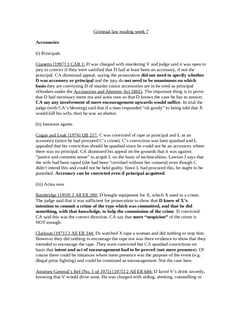R v Howe (Howe, Bannister, Burke, Clarkson) [1987] 2 WLR 568
Judgement for the case R v Howe (Howe, Bannister, Burke, Clarkson)
KEY POINTS
A person exercising duress can be convicted of murder even when the person under duress is convicted of manslaughter only. The person exercising duress may still be held responsible for their actions if their conduct meets the elements of murder, regardless of the charges against the person under duress.
The test of the reasonable person is often applicable in cases of duress. Courts may consider whether a reasonable person would have succumbed to the same level of coercion or threat when evaluating a duress defense.
If a person procured alleges duress and accidental killing, and both the person procured and the procurer are charged with murder, the procurer can still be guilty of murder even if the person procured is only convicted of manslaughter. The procurer's level of intent and their role in causing the death will be assessed separately, and they may still be found culpable for murder if their actions meet the necessary criteria for that charge.
FACTS
In the first appeal, two appellants, accompanied by an intended victim, were taken by an individual named M. to an isolated location where they assaulted the victim, leading to the victim's death at M.'s hands. In another incident, the appellants jointly strangled a different victim. On a third occasion, the intended victim managed to escape. Consequently, the appellants faced two murder charges and one conspiracy to commit murder.
During their trial, the appellants claimed they had acted under duress, fearing for their lives if they did not obey M.'s orders. The trial judge instructed the jury on duress, using a test that assessed whether a sober person of reasonable firmness, sharing the appellants' characteristics, would have reacted by participating in the killings. As a result, the appellants were convicted on all three counts.
In the second appeal, appellants Burke and Clarkson were charged with murdering a man, with Burke as the identified perpetrator. Burke's defense rested on his assertion that he had agreed to shoot the victim out of fear that Clarkson would harm him if he refused, but the gun accidentally discharged.
-
The judge in this case told the jury that Burke, as the actual killer, could not rely on duress as a defense to the murder charge.
However, the jury was instructed to consider duress concerning whether Burke's actions were unintentional, which could lead to a manslaughter charge.
The judge also clarified that if Burke was found guilty of manslaughter, Clarkson could, at most, be convicted of the same offense. Both appellants were ultimately convicted of murder.
The four appellants collectively appealed their convictions, but the Court of Appeal dismissed their appeals. Subsequently, the appellants pursued further appeals.
JUDGEMENT
The appeals were dismissed. Self-defense or protecting one's family is not a valid defense for murder charges, and the duress defense doesn't apply to the actual perpetrator or those who participated in the murder as principals in the second degree.
Thus, the appellants' murder convictions stand.
COMMENTARY
The appeals were dismissed. In the first case, two appellants faced murder charges alongside a conspiracy to commit murder after they, along with another person, assaulted victims in various incidents, resulting in deaths. They claimed duress as a defense, but the jury found them guilty on all counts.
In the second case, appellants Burke and Clarkson were charged with murder, with Burke identified as the perpetrator. Burke argued that he shot the victim out of fear, but the gun went off accidentally. The jury convicted both of murder.
The Court of Appeal upheld their convictions, asserting that self-defense or protecting family members is not a valid defense for murder. Additionally, the duress defense doesn't apply to the actual perpetrator or those involved as principals in the second degree.
ORIGINAL ANALYSIS
Two cases heard together: both cases where Defendants had murdered Victims because they feared that M would kill them if they refused to kill Victims.
HL dismissed the appeals, saying that duress was not a defence to murder, nor is it a defence to murder as an accessory.
Lord Hailsham
Argues against allowing duress as a defence to murder by saying that in cases of killing after WWII the defence of duress was barely distinguishable from the defence of superior orders.
In light of the war crimes committed by the Nazis this is clearly a defence with shortcomings and therefore duress should not be extended to murder.
HL also said that duress fails where a person of reasonable firmness with Defendant’s characteristics would not have given way, where Defendant in fact did.
Lord Mackay
-
Defined duress as the two-part question:
Did Defendant act in response to fear based on reasonable belief as to something X had said or done, and
would a sober person of reasonable firmness have acted in same way as Defendant
RELATED CASES
For Further Study on R v Howe (Howe, Bannister, Burke, Clarkson)
Need instant answers? Our AI exam tutor is here to help.
Ask questions 🙋 Get answers 📔 It's simple 👁️👄👁️
Our AI is educated by the highest scoring students across all subjects and schools. Join hundreds of your peers today.
Get StartedSimilar Cases
Related Product Samples
These product samples contain the same concepts we cover in this case.
| Criminal Law | Defences Notes (32 pages) |
| Criminal Law | Defences Short Notes (28 pages) |
| Criminal Law | Homicide Notes (20 pages) |

 Since 2010, Oxbridge Notes has been a trusted education marketplace, supplying high-quality materials from top achievers at universities like Oxford, Cambridge, LSE, Harvard, and Yale.
Since 2010, Oxbridge Notes has been a trusted education marketplace, supplying high-quality materials from top achievers at universities like Oxford, Cambridge, LSE, Harvard, and Yale.